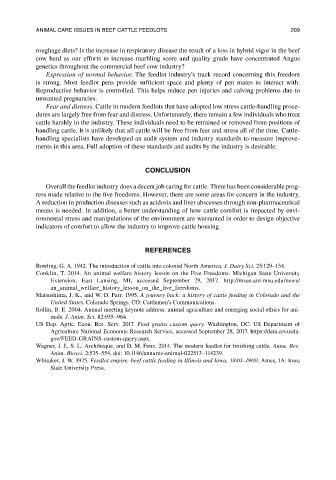Page 232 - The Welfare of Cattle
P. 232
anIMaL Care Issues In beef CattLe feedLots 209
roughage diets? Is the increase in respiratory disease the result of a loss in hybrid vigor in the beef
cow herd as our efforts to increase marbling score and quality grade have concentrated Angus
genetics throughout the commercial beef cow industry?
Expression of normal behavior. The feedlot industry’s track record concerning this freedom
is strong. Most feedlot pens provide sufficient space and plenty of pen mates to interact with.
Reproductive behavior is controlled. This helps reduce pen injuries and calving problems due to
unwanted pregnancies.
Fear and distress. Cattle in modern feedlots that have adopted low stress cattle-handling proce-
dures are largely free from fear and distress. Unfortunately, there remain a few individuals who treat
cattle harshly in the industry. These individuals need to be retrained or removed from positions of
handling cattle. It is unlikely that all cattle will be free from fear and stress all of the time. Cattle-
handling specialists have developed an audit system and industry standards to measure improve-
ments in this area. Full adoption of these standards and audits by the industry is desirable.
CONCLUSION
Overall the feedlot industry does a decent job caring for cattle. There has been considerable prog-
ress made relative to the five freedoms. However, there are some areas for concern in the industry.
A reduction in production diseases such as acidosis and liver abscesses through non- pharmaceutical
means is needed. In addition, a better understanding of how cattle comfort is impacted by envi-
ronmental stress and manipulations of the environment are warranted in order to design objective
indicators of comfort to allow the industry to improve cattle housing.
reFereNCeS
Bowling, G. A. 1942. The introduction of cattle into colonial North America. J. Dairy Sci. 25:129–154.
Conklin, T. 2014. An animal welfare history lesson on the Five Freedoms. Michigan State University
Extension, East Lansing, MI, accessed September 29, 2017. http://msue.anr.msu.edu/news/
an_animal_welfare_history_lesson_on_the_five_freedoms.
Matsushima, J. K., and W. D. Farr. 1995. A journey back: a history of cattle feeding in Colorado and the
United States. Colorado Springs, CO: Cattlemen’s Communications.
Rollin, B. E. 2004. Annual meeting keynote address: animal agriculture and emerging social ethics for ani-
mals. J. Anim. Sci. 82:955–964.
US Dep. Agric. Econ. Res. Serv. 2017. Feed grains custom query. Washington, DC: US Department of
Agriculture National Economic Research Service, accessed September 28, 2017. https://data.ers.usda.
gov/FEED-GRAINS-custom-query.aspx.
Wagner, J. J., S. L. Archibeque, and D. M. Feuz. 2014. The modern feedlot for finishing cattle. Annu. Rev.
Anim. Biosci. 2:535–554. doi: 10.1146/annurev-animal-022513–114239.
Whitaker, J. W. 1975. Feedlot empire: beef cattle feeding in Illinois and Iowa, 1840–1900. Ames, IA: Iowa
State University Press.

